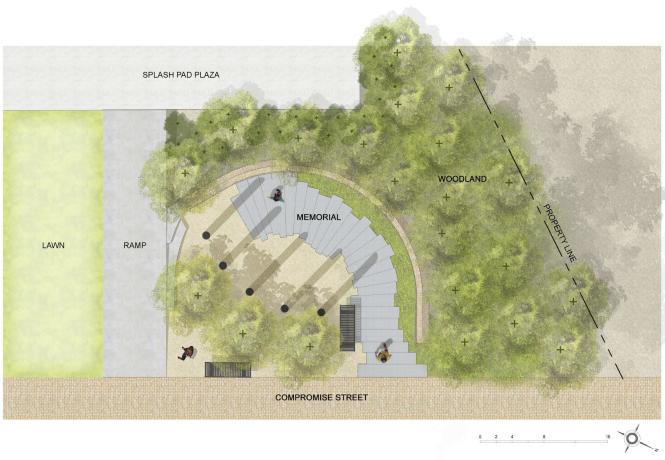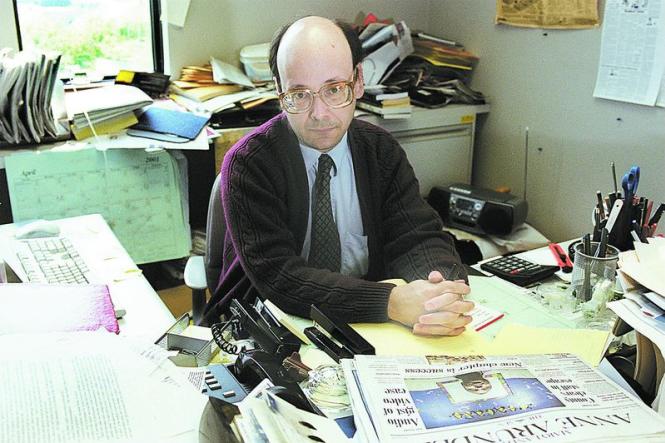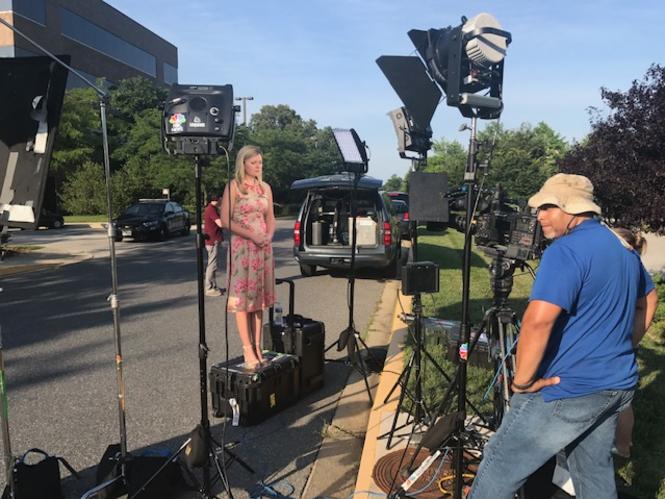When Founding Father James Madison envisioned what became known as the Bill of Rights, he must have had good reason to address freedom of the press as a crucial part of the first of ten Constitutional amendments on his list.
Why we have a First Amendment at all will be the central theme at 10:00 a.m. on June 28 in the Annapolis historic district downtown near the intersection of Newman and Compromise streets. The Maryland General Assembly voted to name June 28 'Freedom of the Press Day' in honor of victims of the Capital Gazette shooting in 2019. There, the city will host a dedication ceremony and ribbon-cutting to unveil a new “Guardians of the First Amendment” memorial. The date pointedly coincides with the third anniversary of what’s become known as the Capital Gazette shootings, with the haunting distinction of being the largest killing of journalists in U.S. history.
 Plan of the memorial located at Newman Park in downtown Annapolis.
Image courtesy of Moody Graham Landscape Architecture.
Plan of the memorial located at Newman Park in downtown Annapolis.
Image courtesy of Moody Graham Landscape Architecture.
The Memorial
The dedication that morning will unveil the culmination of a stunning design progression executed by Moody Graham Landscape Architecture of Washington, D.C. According to advance notice of the program, “the project is supported by the Anne Arundel County Caucus of African-American Leaders, initiated by the Dr. Martin Luther King, Jr. Committee of Maryland, and is a collaboration between state and local governments as well as community organizations, nonprofits, and individual donors.”
Much of the funding for the project came from the Caucus—which was actively involved in selecting the concept for the new memorial—and grants from the state, county, and city, which also provided the downtown location.
Highlights of the memorial include five stone pillars, in homage to the five lost lives at the Capital Gazette. The full wording of the First Amendment and the cover of the Capital from the day after the shooting are etched into the stone on opposite ends of a wall. For a full rundown of the design evolution and details on the memorial itself, visit the Moody Graham Landscape Architecture website.
The Program
A featured speaker is David Simon, who is known more widely for his work on HBO’s “The Wire” but was a police reporter for the Baltimore Sun for 13 years after graduating from the University of Maryland. There, he was editor of The Diamondback student newspaper and caught the journalism bug in the process.
Mr. Simon will be joined by his wife, author Laura Lippman, best known for her 20 detective fiction novels and also as a former Baltimore Sun reporter. Both are family friends of survivors of the journalists killed in 2018. Elected officials, regional journalists, and the surviving reporters and staff from the Capital have also been invited.
 Rob Hiaasen, Capital Gazette Deputy Editor, was killed during the Capital Gazette shooting on June 28, 2018.
His book was published posthumously. Image courtesy of Annapolis Book Festival.
Rob Hiaasen, Capital Gazette Deputy Editor, was killed during the Capital Gazette shooting on June 28, 2018.
His book was published posthumously. Image courtesy of Annapolis Book Festival.
It Could Have Been Any of Us
For the rest of the nation, June 28 three years ago was just another day. Many of us who live in and around Annapolis, however, remember precisely where we were and what we were doing when the unthinkable happened: five local journalism professionals—Gerald Fischman, Rob Hiaasen, John McNamara, Rebecca Smith, and Wendi Winters—shot dead seemingly at random that morning in the newsroom where they worked. The number on the façade of the building, Annapolis’ closest answer to a skyscraper, still frowns its giant “888” down on the largely oblivious Bestgate Road traffic below.
When we heard there had been a shooting at “the capital” many of us immediately thought it had to be the Maryland State House downtown, site of many a political battle in the past, and so a plausible site, if for no other reason than its inherent symbolism. But WNAV radio in Annapolis was reporting the crime scene to be the Capital newspaper offices. Why? Everyone was asking.
Exclusively for this story, 45-year veteran (35 full-time and freelancing 10 and still counting) Capital political cartoonist and columnist Eric Smith recalled his own reaction to the news:
“When I found the Capital at my doorstep barely a day after the horror inflicted on Gerald, Wendi, Rob, John, and Rebecca, I never felt more proud of—or sadder for—my fellow journalists. Under pressure in the extreme, they showed us all the indomitable spirit of the American press.”
 Wendi Winters, Capital Gazette reporter
Image courtesy of the Baltimore Sun
Wendi Winters, Capital Gazette reporter
Image courtesy of the Baltimore Sun
Coincidentally, the writers and editors for What’s Up? Media, publishers of a well-known monthly lifestyle magazine and bimonthly editions dedicated to the city and its environs, had just participated in a “writers’ breakfast” at the company’s headquarters on Defense Highway. Some attendees, including this reporter, had driven past the Capital newsroom that morning to get to and from the writers’ gathering.
 Gerald Fischman, editorial page editor, Capital Gazette.
Image courtesy of the Capital Gazette.
Gerald Fischman, editorial page editor, Capital Gazette.
Image courtesy of the Capital Gazette.
For those of us in the journalism business, what had just happened finally began to sink in, especially since the labels “fake news” and “enemy of the people” were just coming into political vogue at the time. No matter how altruistically and thanklessly members of the press approach their jobs—in pursuit of what well-known journalist Bob Woodward (who incidentally owns waterfront property here) likes to call “the best obtainable version of the truth”—the targets that day could easily have been any of us.
 Rob Hiaasen, Capital Gazette Deputy Editor.
Image courtesy of the Baltimore Sun.
Rob Hiaasen, Capital Gazette Deputy Editor.
Image courtesy of the Baltimore Sun.
‘What Real Journalists Do’
With the news still fresh and raw, this reporter wrote “An Attack on Journalism” exclusively for the What’s Up? website the following day. It was an appreciation of “what real journalists do. The best ones run toward a story and not away from it—no matter the imposition or the danger.” Included was “the essence of dedicated reporting” illustrated by Capital reporter Chase Cook’s assurance that “We are putting out a damn paper tomorrow.”
 John McNamara, reporter and editor, Capital Gazette.
Image courtesy of the Baltimore Sun.
John McNamara, reporter and editor, Capital Gazette.
Image courtesy of the Baltimore Sun.
Only weeks later, Ellen Moyer, former Annapolis mayor and a regular contributor to the magazines, wrote a longer analysis, also using the word “attack” to describe what had transpired against the very fabric of journalism. In her story, Mayor Moyer pointed out that the Annapolis Gazette published the first newspaper in 1727, “which in 50 years would be a leading mouthpiece in the fight for a new nation.” Today, the Capital, part of the Capital Gazette group, “still exists as the oldest continuously published newspaper” in the United States.

Words from A Network TV Reporter
Reporting live from Annapolis “from her hometown” the morning after the Capital shootings was NBC correspondent Catie Beck, a familiar name in this city where she grew up and attended school. When she heard about the upcoming First Amendment commemoration event this June 28, she sent the following message to accompany this story:
People who call Annapolis home are proud of it, myself included. We shouldn’t see this shooting as a dark moment to forget. We have a strong community. I’d like to think our local journalists have helped to build it. This memorial will force us to remember and honor them. If only for a minute or two in passing, it will mean something.
 NBC correspondent Catie Beck reporting on the morning of June 29, 2018
Image courtesy of NBC News.
NBC correspondent Catie Beck reporting on the morning of June 29, 2018
Image courtesy of NBC News.
• As this report was undergoing finishing touches before deadline, the Poynter Institute for Media Studies in St. Petersburg, Florida, released a story on June 17 by Kristen Hare, who “covers the people and business of local news” for the institute. It announced that part of the recent Alden Global Capital hedge-fund acquisition of Tribune publishing, until then the Capital’s umbrella owner, has timed its buyout of the Annapolis newspaper’s Pulitzer-Prize-honored editorial staff to occur at the time of the third anniversary of the 2018 shooting, “a particularly cruel move,” Hare wrote.









